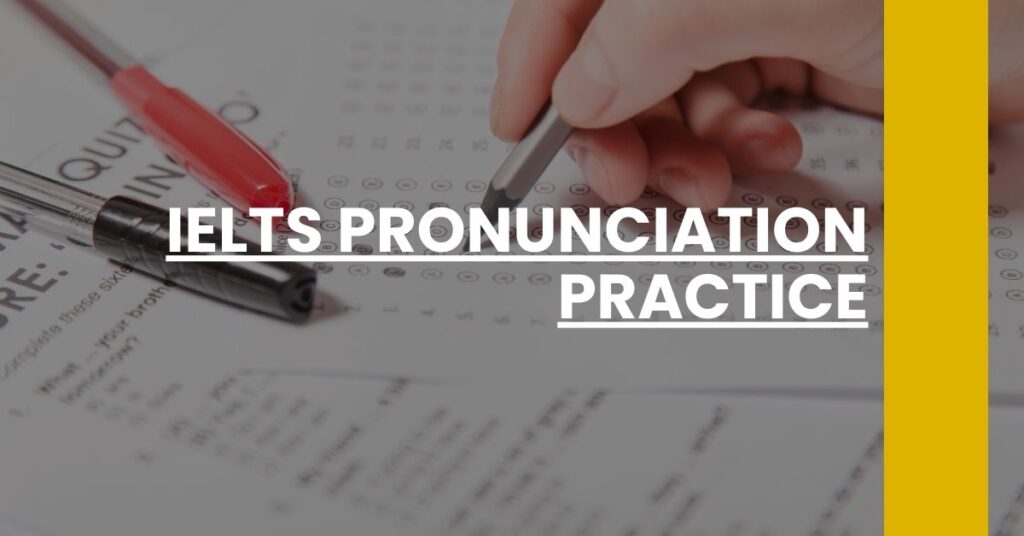Master the art of IELTS pronunciation practice with our focused strategies.
- Precision in Sound: Achieve exactness in pronunciation with step-by-step guidance.
- Rhythm & Intonation: Learn to naturally integrate stress patterns and intonation essential for clarity.
- Practical Exercises: Engage in targeted practice techniques that deliver results.
Elevate your IELTS speaking score with effective pronunciation practice.
- Understanding IELTS Pronunciation Criteria
- Phonetic Alphabet and Sound Recognition
- The Role of Stress and Intonation
- Techniques to Improve Pronunciation
- Mouth Mechanics and Pronunciation
- Practice with Common IELTS Vocabulary
- Using Tongue Twisters and Poetry for Practice
- Leveraging Technology for Pronunciation Practice
- Common Challenges and How to Overcome Them
- Tips from High-Scoring Candidates
- Conclusion
Understanding IELTS Pronunciation Criteria
When diving into IELTS pronunciation practice, it’s essential to grasp what examiners are attentive to. Your pronunciation is more than just your accent; it’s a critical component that can steer your Speaking test score. Here’s what you should focus on:
- Clarity: Your words need to be sharp and distinct. Each syllable should be recognizable, without merging into the next.
- Fluency: It’s not just about speed but about smoothness. A natural flow in your speech can boost comprehension.
- Range of Pronunciation Features: The dynamic use of stress, intonation, rhythm, and linking sounds can exhibit a command of English pronunciation.
The importance of pronunciation cannot be overstated. It’s not ‘just another box to tick off’ but a defining element in communication. An impeccable command of pronunciation can make the difference between being understood instantly or not.
Why Is Pronunciation So Vital in IELTS?
The pronunciation is enshrined as a core judging criterion because it directly influences how effectively you communicate. A clear accent aids in transmitting your message without the cloud of misunderstanding. Moreover, it’s not about having a British or American accent; rather, it’s about being understood regardless of your mother tongue. This is well-established as a cornerstone of the IELTS assessment guidelines.
Phonetic Alphabet and Sound Recognition
Embarking on IELTS pronunciation practice, you may encounter the International Phonetic Alphabet (IPA). This is an indispensable map to mastering the specific sounds of English. Each symbol correlates with a distinct sound, allowing for precise pronunciation.
How Can the IPA Enhance Your Pronunciation?
The IPA dispels the confusion that inconsistent English spelling can bring. For example, ‘cough’ and ‘through’ look similar but sound significantly different. The IPA provides the clarity needed here.
- Identify Sound Patterns: Recognizing how words are pronounced through IPA symbols.
- Practice Makes Perfect: Repeated use of the IPA symbols in reading and writing can cement the correct sounds in your vocabulary.
To harness the true potential of the IPA in your IELTS pronunciation practice, familiarize yourself with these symbols by exploring resources crafted to facilitate their learning.
The Role of Stress and Intonation
The inflections in your voice when you speak — the rise and fall, the emphatic stresses on certain syllables — this is the essence of stress and intonation. These aren’t just fanciful additions; they’re foundational to conveying meaning.
How Do Stress and Intonation Affect Communication?
Addressing stress and intonation can:
- Convey Subtleties in Meaning: A word can change its meaning entirely based on where the stress is placed.
- Indicate Questions and Statements: Rising intonation often signals a question, while falling intonation is common in statements.
- Signal Emotional Content: Whether you’re excited, skeptical, or bored can be clear through your intonation patterns.
For insightful exploration into the importance of stress and intonation, consider exploring the impact stress has on understanding and conveying English speech.
Techniques to Improve Pronunciation
To truly excel in your IELTS pronunciation practice, try incorporating a mix of strategies:
- Listen and Repeat: Pick up nuances by listening to native speakers and mimicking their pronunciation patterns.
- Self-Recording: Record your speech to pinpoint areas requiring improvement.
- Phonetic Exercises: Engage with IPA-driven pronunciation drills to hone specific sounds.
- Use Pronunciation Apps: Apps with speech recognition can offer real-time corrections.
The goal is to nurture instinctive pronunciation that feels as natural to you as your first language.
Are There Tools to Help with Pronunciation?
Absolutely. Apart from personal tutoring, there are numerous digital tools available. For example, ELSA Speak provides AI-backed spoken feedback that can guide you on your journey to better pronunciation.
Mouth Mechanics and Pronunciation
You might not think it, but the way your mouth moves plays a substantial role in producing the varied sounds of English.
Why You Should Understand the Physiology of Speech
- Sound Precision: Knowing how to place your tongue or shape your lips can make or break a sound.
- Error Correction: Identifying which muscle groups are involved can aid in correcting mispronunciations.
Take the time to explore how the vocal organs function – their interaction is the bedrock of accurate pronunciation. Whether it’s mastering the subtle difference between ‘vat’ and ‘bat’ or ensuring the clarity of your ‘th’ sounds, understanding vocal mechanics is a cornerstone of excellent IELTS pronunciation practice.
Practice with Common IELTS Vocabulary
When you embark on IELTS pronunciation practice, it’s paramount to also intertwine your studies with high-frequency IELTS vocab. Familiarity with these terms can be transformative, as it boosts your confidence when you seamlessly pronounce these words during the IELTS Speaking test.
- Useful Word Lists: Focus your practice on words that appear often in IELTS tests. Strengthen your pronunciation with these targeted lists.
- In Context Practice: Utilize these words in sentences and practice speaking them aloud to understand how they blend in real conversation.
- Vocabulary Journals: Keep a log of challenging words and track your progress.
By integrating common IELTS vocabulary into your study routine, you assimilate not just their meanings but also their phonetic nuances. For a comprehensive understanding of frequent IELTS terms and sound articulation, it can be beneficial to explore reliable IELTS vocabulary resources, such as IELTS vocabulary lists.
Using Tongue Twisters and Poetry for Practice
Twist Your Tongue to Success
Tongue twisters aren’t just for fun—they’re a goldmine for IELTS pronunciation practice. Here’s why:
- Consonant Clusters: Navigating through complex clusters can sharpen your articulation.
- Speed and Rhythm: They help you maintain speech control even as your pace varies.
- Memory and Focus: Tongue twisters require concentration, enhancing overall language retention.
Poetry: The Art of Pronunciation
Poetry is rhythm and melody woven into words—the perfect practice ground for prosody.
- Natural Flow: Capture the rhythm and stress patterns within verses.
- Emotive Intonation: Bring the lines to life with pitch modulation, closely mimicking natural speech inflections.
Through the repetition and practice of tongue twisters and poignant poetry, you can refine your pronunciation in a way that feels less like study and more like performance art.
Leveraging Technology for Pronunciation Practice
Harness the power of digital innovation to pitch-perfect your English pronunciation. Here’s how technology can be an integral part of your IELTS pronunciation practice:
- Speech Recognition Software: Use tools that analyze your speech patterns and offer constructive feedback.
- Pronunciation Apps: Interactive apps like ELSA Speak serve as a pocket coach, guiding you through tailored pronunciation exercises.
- Online Pronunciation Guides: Websites and video platforms can be a go-to resource for quick pronunciation tips and demonstrations.
In the age of smart learning, incorporating these tech solutions can equip you with the insights to improve swiftly. If you’re looking for technology that responds to your dialect and offers personal corrections, delve into apps that utilize speech recognition technology.
Common Challenges and How to Overcome Them
You’re not alone if you’ve hit a wall in your IELTS pronunciation practice. Many face hurdles, but here’s how to vault over:
- Different Phonemes: Break down unfamiliar phonemes into smaller, manageable components.
- Pacing Issues: Slow down. It’s not a race to the finish—clarity is your ally, not speed.
- Mother Tongue Influence: Embrace your native language, but be aware of its impact on your English pronunciation.
Addressing Pronunciation Plateaus
Find comfort in knowing that stepping past these challenges can be as simple as incorporating diverse practice methods and seeking feedback from language partners or tutors.
Tips from High-Scoring Candidates
How do those who’ve conquered the IELTS Speaking test do it? Their secrets aren’t so secret after all:
- Imitation Practice: Mimic speakers from various English media to adapt different accents and speaking styles.
- Discipline and Consistency: Steadfast daily practice can make a sizable impact over sporadic study bursts.
Gleaning strategies from high-scoring candidates reveals a theme—discipline intertwined with smart, varied practice leads to success.
Conclusion
With the keys to effective IELTS pronunciation practice within reach, the next step is applying these tactics consistently. Remember, mastering pronunciation doesn’t happen overnight, but with dedication, your Speaking test performance can reach new heights. ConfigureServices the tools, tips, and techniques shared here, and watch your pronunciation—and confidence—soar. Your ability to communicate clearly in English is a journey worth embarking on, and every moment of practice is a step towards IELTS success.
Master IELTS pronunciation practice with proven strategies and tips to boost your speaking score. Start refining your skills today!

